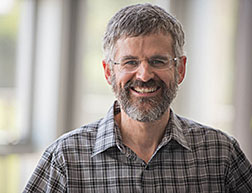- Number 399 |
- October 14, 2013
Sensor expert Kent Irwin joins SLAC

New faculty member Kent Irwin brings his
expertise in quantum sensors to SLAC and
Stanford. (Matt Beardsley/SLAC)
Here's a physics riddle: What do hunting for dark matter, studying the universe's very beginnings and probing the behavior of exotic materials have in common?
One answer is Kent Irwin, who recently came to DOE's SLAC National Accelerator Laboratory from the National Institute of Standards and Technology (NIST), with joint appointments in the SLAC Particle Physics and Astrophysics and Photon Science directorates and on the Stanford University physics faculty. What Irwin has, aside from an inexhaustible supply of energy, is a fascination for fundamental cosmological questions and decades of experience building some of the most delicate sensors in the world – sensors capable of detecting single photons or the infinitesimal vibrations caused by a particle, possibly dark matter, striking a germanium crystal lattice.
"My main interests are in understanding the properties of dark matter and dark energy, determining the numbers and masses of neutrino species, and probing cosmic inflation and the cosmic gravity wave background," Irwin said, reeling off several outstanding questions having to do with the origin of the universe.
The move is a homecoming of sorts; prior to his nearly two decades at NIST, where he rose from postdoctoral researcher to NIST Fellow and adjoint professor of astrophysics and planetary sciences at the University of Colorado, Irwin did his graduate research with Stanford physicist Blas Cabrera.
Under Cabrera's tutelage, Irwin's fascination with the biggest cosmological questions led him to focus on developing instruments that capture some of the faintest signals detectable. His main area of expertise is in the construction of transition edge sensors, cryogenically cooled sensors that hover on the edge of superconductivity – the "transition edge" of the sensor's name.
Superconductors must remain at or below a certain critical temperature to do their job, which is conducting an electrical current with no resistance. When a material is at this transition edge, the tiny bit of heat deposited by an incoming particle makes a big difference in the resistance of the material. Measuring the size of that change in resistance tells scientists how much the material has warmed and how much energy was deposited in the sensor – and thus what sort of particle might have put it there.
Irwin is at the forefront of creating sensors that not only remain stable in this delicately balanced state, but can also be joined together into large sensor arrays. Among other honors, Irwin's work has earned him the Joseph F. Keithley Award for Advances in Measurement Science from the American Physical Society in 2007.
Sensors built by his team at NIST are found in instruments from the South Pole to Hawaii to the Atacama Desert in Chile. But transition edge sensors are not confined to astrophysics research. "They also apply to materials research," Irwin said, and one of his first projects at SLAC is to develop instruments for the lab's two photon science facilities – the Stanford Synchrotron Radiation Lightsource and the Linac Coherent Light Source X-ray laser. "The sensors can be tuned to respond to everything from microwaves to X-rays," Irwin said. "There's a really great opportunity to use this technology at light sources."
Irwin hasn't forgotten his first love – he's a full-fledged member of the Kavli Institute for Particle Astrophysics and Cosmology, a joint SLAC-Stanford institute. He'll be working with KIPAC researcher Chao-Lin Kuo to develop sensors for studying how the cosmic microwave background, the relic photons left over from the Big Bang, has been polarized by primordial gravitational waves.
But Irwin expects the technologies he develops for cosmological research to find their way into many different fields; that’s why he joined both the PPA and Photon Science directorates. "We can have a really high impact at light sources with the technology we develop for fundamental physics,” he said.Submitted by DOE's SLAC National Accelerator Facility
